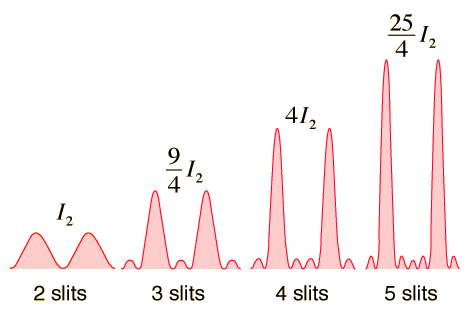- Joined
- Apr 29, 2011
- Messages
- 2,171
- Reaction score
- 863
TBR says that if the same total light intensity is used in both the double-slit and the diffraction grating experiments, then the bright spots of the interference pattern in the diffraction grating experiment will be
A. More intense and spaced together more closely than in the double-slit experiment
B. “More intense and spaced farther apart than in the double-slit experiment”
C. “Less intense and spaced together more closely than in the double-slit experiment
D. “Less intense and spaced farther apart than in the double-slit experiment”
Here’s most of TBR’s lengthy and (IMO, confusing) answer explanation:
“We know that a fixed amount of light should reach the screen, so if the number of spots decreases, the intensity of each remaining spot should increase. This makes choices C and D highly unlikely answers. [*see my comment below]
The maxima appear at the screen when light from all the slits are constructively interfering. In Young’s experiment, there are only two slits whose light must interfere constructively. The maxima, therefore, appear periodically across the screen, whenever the path-length difference between the two light rays is equal to some integral number of wavelengths. With a diffraction grating, the constructive spots will, again, appear when the light rays from all slits are interfering as constructively as that can.
Since the light rays emanating from several slits must now interfere in phase, the likelihood of a maximum is much smaller than it is in the double-slit experiment. Therefore, the spacing between maxima must be larger with the diffraction grating; this rules out choices A and C.
The diffraction grating maxima will also be much narrower than the double-slit maxima. Regarding the intensity, we know that a bright spot at the screen must occur because several light paths are constructively interfering. Since ‘several’ is a number bigger than two (as in the double-slit experiment) and because the maxima are now much narrower, the maxima intensity must be greater for the diffraction grating experiment”
*This makes no sense to me. Using such logic, choices C and D should be the only ones that remain because the double-slit experiment has fewer holes. Thus, each hole in the double-slit experiment should have greater intensity. In the last paragraph, TBR kind of suggests that the diffraction grating could have greater intensity since there are more instances of constructive interference with more holes. I mean I can somewhat understand that but how do you know it outweighs the fact that there are more holes in the diffraction grating (making the amount of light entering each grating smaller)?
A. More intense and spaced together more closely than in the double-slit experiment
B. “More intense and spaced farther apart than in the double-slit experiment”
C. “Less intense and spaced together more closely than in the double-slit experiment
D. “Less intense and spaced farther apart than in the double-slit experiment”
Here’s most of TBR’s lengthy and (IMO, confusing) answer explanation:
“We know that a fixed amount of light should reach the screen, so if the number of spots decreases, the intensity of each remaining spot should increase. This makes choices C and D highly unlikely answers. [*see my comment below]
The maxima appear at the screen when light from all the slits are constructively interfering. In Young’s experiment, there are only two slits whose light must interfere constructively. The maxima, therefore, appear periodically across the screen, whenever the path-length difference between the two light rays is equal to some integral number of wavelengths. With a diffraction grating, the constructive spots will, again, appear when the light rays from all slits are interfering as constructively as that can.
Since the light rays emanating from several slits must now interfere in phase, the likelihood of a maximum is much smaller than it is in the double-slit experiment. Therefore, the spacing between maxima must be larger with the diffraction grating; this rules out choices A and C.
The diffraction grating maxima will also be much narrower than the double-slit maxima. Regarding the intensity, we know that a bright spot at the screen must occur because several light paths are constructively interfering. Since ‘several’ is a number bigger than two (as in the double-slit experiment) and because the maxima are now much narrower, the maxima intensity must be greater for the diffraction grating experiment”
*This makes no sense to me. Using such logic, choices C and D should be the only ones that remain because the double-slit experiment has fewer holes. Thus, each hole in the double-slit experiment should have greater intensity. In the last paragraph, TBR kind of suggests that the diffraction grating could have greater intensity since there are more instances of constructive interference with more holes. I mean I can somewhat understand that but how do you know it outweighs the fact that there are more holes in the diffraction grating (making the amount of light entering each grating smaller)?

